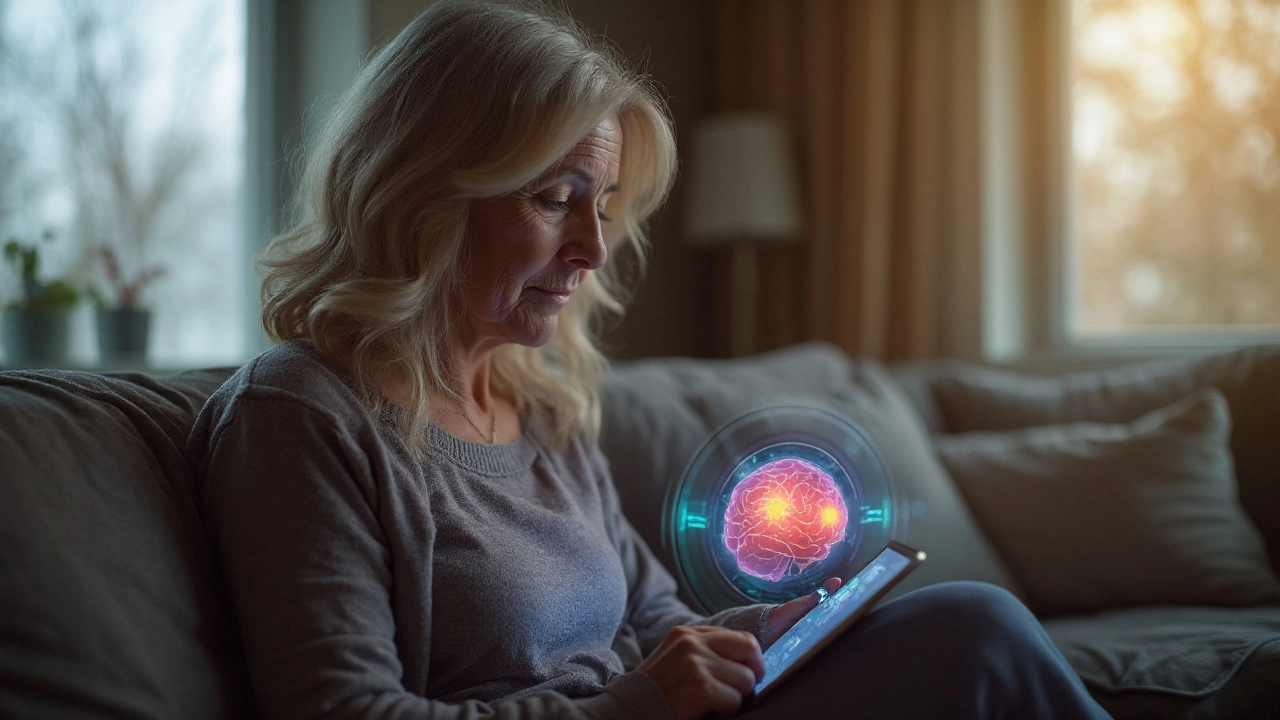RRMS Sensory Flare‑Up Checker
Quick Takeaways
- Relapsing‑remitting disease (RRMS) attacks myelin, directly disrupting sensory pathways.
- Common sensory symptoms include tingling, numbness, pain, visual flickers, and heat‑induced flare‑ups.
- Early MRI, evoked potentials, and quantitative sensory testing help differentiate disease‑related issues from unrelated neuropathies.
- Disease‑modifying therapies (DMTs) lower relapse frequency, indirectly easing sensory complaints.
- Lifestyle tweaks-temperature control, targeted exercise, and mindfulness-can reduce symptom intensity.
Understanding the Core Condition
Relapsing‑Remitting Multiple Sclerosis (RRMS) is a form of multiple sclerosis characterized by episodic neurological decline followed by partial or full recovery. It accounts for roughly 85% of all MS diagnoses worldwide (World Health Organization, 2024). During a “relapse,” immune cells breach the blood‑brain barrier, stripping the protective myelin sheath from axons in the central nervous system (CNS). When myelin is damaged, electrical signals slow or misfire, which is the biochemical root of sensory disturbances.
The disease’s hallmark is its unpredictability: a patient might feel fine for months, then suddenly experience numbness in a hand or a burning foot. This pattern makes it hard for clinicians and patients alike to separate RRMS‑related sensory issues from other causes such as diabetes or peripheral neuropathy.
How Demyelination Fuels Sensory Dysfunction
Demyelination is the loss or damage of the myelin insulating nerve fibers. In RRMS, demyelination occurs primarily in the brain’s white‑matter tracts that carry sensory information from peripheral receptors to the cortex. When these pathways are compromised, patients report:
- Reduced vibration sense in the feet.
- Erratic temperature perception (heat makes symptoms worse).
- Spatial disorientation, especially during a relapse affecting the dorsal columns.
Because the CNS cannot instantly regenerate myelin, the brain attempts to reroute signals via alternative pathways. This neuro‑plastic adaptation often creates “mis‑wiring,” manifesting as tingling (paresthesia) or phantom sensations.
Typical Sensory Symptoms in RRMS
Patients with RRMS frequently describe a quartet of sensory complaints:
- Paresthesia: Pins‑and‑needles, usually starting in the toes or fingers.
- Neuropathic Pain: Burning or electric‑shock sensations triggered by even mild stimuli.
- Visual Disturbances: Flickering, blurred vision, or "color loss" due to optic neuritis.
- Heat Sensitivity (Uhthoff’s phenomenon): Temporary worsening of symptoms when body temperature rises.
These issues can appear in isolation or together, often varying with disease activity.
Diagnostic Tools Linking Relapse Activity to Sensory Issues
Accurately attributing sensory complaints to RRMS requires a multimodal approach.
MRI Imaging
MRI magnetic resonance imaging reveals new or enhancing lesions that correlate with fresh sensory deficits is the gold‑standard. Gadolinium‑enhancing lesions indicate active inflammation, often preceding a relapse that includes sensory flare‑ups.
Evoked Potentials
Visual and somatosensory evoked potentials measure the speed of electrical conduction along sensory pathways. Delayed latencies suggest demyelination, even when MRI looks quiet.
Quantitative Sensory Testing (QST)
QST objectively quantifies thresholds for vibration, thermal perception, and pain. Consistent deficits across multiple sessions strengthen the RRMS‑sensory link.

Managing Sensory Problems: Medical and Lifestyle Strategies
The goal is two‑fold: limit new demyelination and alleviate existing symptoms.
Disease‑Modifying Therapies (DMTs)
Disease‑Modifying Therapy medications that reduce relapse frequency and slow lesion formation include interferon‑β, glatiramer acetate, and newer oral agents like dimethyl fumarate. Clinical trials (e.g., REFLEX 2023) show a 40% reduction in relapse‑related sensory episodes among patients on high‑efficacy DMTs.
Symptomatic Treatments
- Neuropathic Pain: Gabapentin or duloxetine, titrated to response.
- Spasticity‑related tingling: Baclofen or tizanidine.
- Optic neuritis management: High‑dose IV methylprednisolone during acute attacks.
Physical Therapy & Occupational Therapy
Targeted balance exercises, proprioceptive training, and graded exposure to temperature changes help the CNS rewire safely, reducing mis‑wiring sensations.
Heat Management (Uhthoff’s Phenomenon)
Simple actions-cool showers, air‑conditioned environments, and cooling vests-can prevent temporary worsening of sensory symptoms during warm weather or exercise.
Mind‑Body Approaches
Meditation, biofeedback, and paced breathing have been shown in small RCTs (2022) to lower perceived pain intensity by up to 25%.
Related Concepts and Connected Topics
Understanding the sensory facet of RRMS opens doors to several adjacent areas:
- Optic Neuritis: Inflammation of the optic nerve that often initiates visual sensory loss.
- Fatigue: A pervasive symptom that amplifies sensory perception problems.
- Mobility Impairment: Sensorimotor deficits that compound balance issues.
- Autoimmune Response: The underlying trigger for demyelination.
- Neuroplasticity: The brain’s ability to adapt, which can be harnessed through rehab.
These topics reside within the broader Health and Wellness cluster, while more narrow deep‑dives-like “Managing Optic Neuritis Pain” or “Neuroplasticity Exercises for MS”-make logical next reads.
Comparison: Relapsing‑Remitting MS vs Primary Progressive MS (Sensory Perspective)
| Attribute | RRMS | PPMS |
|---|---|---|
| Onset pattern | Discrete relapses with recovery | Steady progression, no clear relapses |
| Typical sensory flare‑ups | Common during relapses (paresthesia, pain) | Gradual numbness, less acute pain |
| Response to DMTs (sensory outcomes) | High efficacy, reduces flare frequency | Modest; many DMTs less effective |
| Heat sensitivity | Pronounced (Uhthoff’s) | Variable, often milder |
| MRI activity (new lesions) | Frequent enhancing lesions | Fewer new lesions, more atrophy |
Practical Checklist for Patients and Caregivers
- Track sensory changes in a daily journal - note time, temperature, and activity.
- Schedule MRI scans at least annually, or sooner after a new sensory episode.
- Review DMT side‑effects with neurologist every 6months.
- Implement a cooling strategy before exercise (e.g., cooling vest for 15minutes).
- Engage in a 30‑minute proprioceptive routine twice weekly (balance board, foam rolls).
- Discuss pain medication adjustments promptly; avoid long‑term high‑dose opioids.
Next Steps and Further Reading
After grasping how relapsing‑remitting disease fuels sensory issues, readers often ask:
- How does diet influence myelin repair?
- What emerging therapies target neuro‑protection?
- Can wearable sensors predict an upcoming sensory flare?
Future articles will explore these questions, linking nutrition science, clinical trial updates, and digital health innovations.
Frequently Asked Questions
Why do I feel tingling only during a relapse?
During a relapse, immune cells attack the myelin covering sensory pathways. The sudden loss of insulation slows signal transmission, producing the classic pins‑and‑needles feeling. Once inflammation subsides and some remyelination occurs, the tingling often eases.
Can MRI miss lesions that cause sensory symptoms?
Standard MRI captures most demyelinating lesions, but tiny cortical plaques or spinal cord lesions can be overlooked, especially without contrast. That's why clinicians combine MRI with evoked potentials and quantitative sensory testing for a fuller picture.
What lifestyle changes help reduce neuropathic pain?
Keeping a cool environment, engaging in low‑impact aerobic activities (swimming, stationary bike), and practicing mindfulness‑based stress reduction have all shown modest pain relief. Consistent stretching improves blood flow and can lessen burning sensations.
Are DMTs effective for sensory symptoms alone?
DMTs don’t directly target pain, but by lowering relapse frequency they indirectly reduce the number of new sensory flare‑ups. For acute pain, adjunct medications are usually required.
How does heat trigger worsening of symptoms?
Higher body temperature further impairs the already damaged ion channels in demyelinated nerves, slowing conduction even more. This phenomenon, called Uhthoff’s, is reversible - cooling the body restores normal signal speed.
Is there a test that predicts a future sensory relapse?
Research is ongoing on wearable accelerometers and skin‑temperature patches that flag subtle changes before a clinical relapse. As of 2024, no FDA‑cleared predictive tool exists, but early data are promising.



7 Comments
Mica Massenburg September 23, 2025 AT 06:56
They've been hiding the real cause of these flare‑ups behind fancy drug patents.
Sarah Brown October 4, 2025 AT 14:56
Great guide! For anyone dealing with RRMS‑related tingling, tracking temperature changes in a simple notebook can reveal patterns you might otherwise miss. Pair that with a cooling vest before workouts, and many users report noticeable relief. Also, don’t underestimate the power of gentle yoga-slow stretches help keep the nervous system calm without risking overheating.
Matt Quirie October 15, 2025 AT 22:56
While it is understandable that concerns arise regarding pharmaceutical influences, the data - particularly the results from the REFLEX 2023 trial - demonstrates a statistically significant reduction in relapse‑associated sensory episodes among patients adhering to approved disease‑modifying therapies; therefore, attributing symptomatology solely to conspiratorial motives may overlook the substantial body of peer‑reviewed evidence supporting the efficacy and safety of these agents.
Pat Davis October 27, 2025 AT 05:56
It is essential to recognize that sensory disturbances in RRMS are not merely isolated events but reflections of broader demyelination processes within the central nervous system; consequently, a multidisciplinary approach encompassing neurology, physiotherapy, and patient education yields the most robust outcomes.
Mary Wrobel November 7, 2025 AT 13:56
Exactly! Think of the brain as a bustling city-when the power lines (myelin) get damaged, the lights flicker. Adding a dash of cool air, a sprinkle of gentle movement, and a pinch of mindfulness can keep that city humming smoothly. The result is a richer, more vibrant daily experience for everyone affected.
Lauren Ulm November 18, 2025 AT 21:56
Honestly, the interplay between hidden agendas and genuine scientific progress feels like a modern ⚖️ dance, where each step is scrutinized by both skeptics and believers. The guide does an excellent job of breaking down the mechanisms behind Uhthoff’s phenomenon, yet one cannot ignore that the very labs developing cooling vests are often funded by the same pharmaceutical giants that market DMTs. 🎭 That duality reminds me of the age‑old paradox: are we patients or test subjects in an ever‑expanding market? Still, the practical checklist you offered-especially the daily symptom journal-serves as a powerful tool for self‑advocacy. 🌱 By logging temperature spikes alongside medication timing, patients can generate personal data that may even inform their neurologist’s decisions. Moreover, the mention of quantitative sensory testing (QST) bridges the gap between subjective feeling and objective measurement, a crucial step toward demystifying “just in my head” narratives. 🧠 While some may argue that mindfulness is merely a trendy fad, the neuroplasticity literature suggests that focused attention can indeed modulate pain pathways. 💡 In short, blend the hard science with the soft‑skill strategies, and you’ll have a holistic plan that respects both the body’s biology and the mind’s resilience. Let’s keep questioning, keep experimenting, and most importantly, keep sharing our lived experiences-after all, collective insight is the best antidote to corporate opacity. 🚀 Each entry in your journal becomes a piece of evidence that can counter vague medical jargon. When you correlate flare‑ups with heat exposure, you also empower your care team to adjust therapy before a full‑blown relapse. Some emerging wearable devices even promise to alert you minutes before a temperature threshold is crossed, turning data into pre‑emptive action. Even if those gadgets are not yet FDA‑cleared, the principle of early detection remains sound. And remember, the psychosocial aspect-support groups, online forums, family involvement-can significantly buffer the stress that amplifies sensory symptoms. Stress hormones themselves can lower the conduction velocity in demyelinated fibers, creating a feedback loop of pain and anxiety. Thus, integrating relaxation techniques, such as paced breathing, is not just a nice‑to‑have but a neurophysiologically grounded intervention. Finally, stay vigilant about the evolving landscape of neuro‑protective therapies; the pipeline is full of candidates aiming to repair myelin rather than merely suppress inflammation. Your proactive stance, combined with cutting‑edge research, will chart a path toward better quality of life.
Michael Mendelson November 30, 2025 AT 05:56
lol, u think those fancy papers trump the real world? i mean, sure, stats are nice, but most peeps cant even afford the meds u brag about. gimme a break.